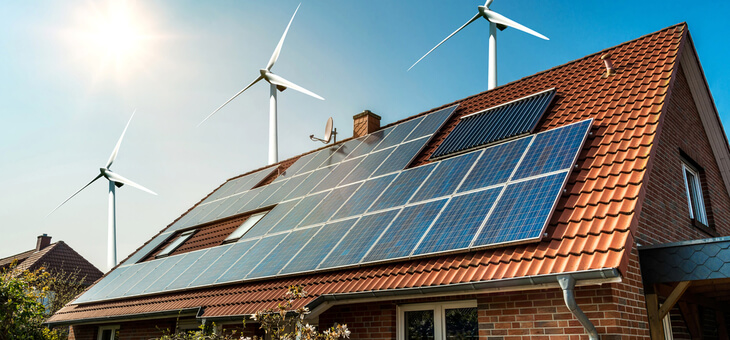Climate change can seem too big to solve or a problem that’s just for politicians. But the reality is living in a net zero country is everyone’s business and we all have our part to play.
Yes, transport and agriculture are responsible for a big chunk of emissions, but our homes also emanate their fair share.
Australian households are responsible for 33.5 per cent of our domestic emissions via home energy and personal cars, according to Rewiring Australia.The truth is there are a number of changes you can make in your home that are good for your wallet and for climate change.
There are two ways to look at it, and the first is your source of energy. Many households still rely on electricity from the grid, which is mainly derived from burning coal. The alternative is installing solar panels on your roof to make your own clean energy and rely less on the grid.
Read: Aussies more concerned about going green than costs
Many Aussies are already on it. As a nation, we have the highest penetration of rooftop solar in the world, with panels sitting on nearly three million homes across the country. That’s three million homes making their own clean energy. In 2020, we hit an all-time record of 362,000 homes switching to solar. Our latest study of homeowners with solar shows they save on average $922 on their electricity bill per year.
The next piece of the puzzle is looking at how your appliances and services are powered – what energy are they using and how is it contributing to household emissions? The best way to tackle that is to gradually convert all your appliances to run on electricity or to ‘electrify everything’.
What does that look like? It means replacing gas-powered appliances and technologies with alternatives that run on electricity. Do you have a gas stove? Replace it with an induction cook top. Use gas heating? Swap it for a reverse-cycle air conditioner. Have a gas water heater? Switch to electric and/or solar. And, eventually, switch your petrol car for an electric vehicle (EV).
Read: Does your energy company take climate change seriously?
If you generate your own energy through rooftop solar and electrify everything, you can power your home with clean energy and reduce your dependence on the grid. It’s like growing your own vegies. If you grow carrots, you’re going to use them in your next meal. Sure you might need to buy carrots and other vegetables from the store to top up, but you start to try to rely on your vegie patch when you can.
It’s the same for solar energy. If you generate your own energy, then you think of ways you can use as much of it in your own home as you can and try to reduce your reliance on other energy forms.
While there might not be an EV sitting in your garage in the next year, you can upgrade your stove or air conditioner much sooner. I’m not suggesting all these changes must happen immediately and we should be removing perfectly functioning appliances and systems. But it’s something to think about when the time comes to replace existing items. Something to add to your roadmap of home improvements.
There are probably a number of things in your home you look at and think, ‘I’ll need to upgrade that in a few years.’ Why not electrify them to reduce your bills, household emissions anduse the power you generate to power more of your home?
Read: Is your nest egg at risk from climate change?
By upgrading to these existing technologies, you can live in a home that generates fewer carbon emissions, with lower energy costs. Electricity can be easily generated from clean, cost-effective, and renewable sources such as solar, wind, and hydro power.
Rewiring Australia estimates that by 2030, Australian families could be saving $5000 per year by adding solar panels, switching to electric vehicles and replacing their natural gas heating systems (water heating, space heating, or kitchen) to electric heat pumps.
Making your home sustainable starts with what might seem like small decisions made in your living room, but collectively they’ll add to lower bills, cleaner energy and fewer emissions. It’s time to shift power back to the home.’
Katherine McConnell is CEO and founder of Brighte, a credit technology platform making it easier for Australians to pay for home energy and home improvements.
Will you gradually cull all gas from your household? Have you identified the savings you could make? Why not share your views in the comments section below?
If you enjoy our content, don’t keep it to yourself. Share our free eNews with your friends and encourage them to sign up.

